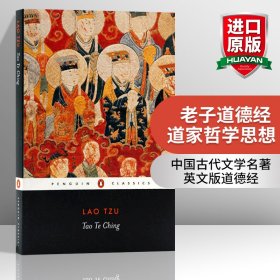
英文原版 Tao Te Ching 道德经 企鹅黑经典 Penguin Black Classics 英文版 进口英语原版书籍
书籍内容简介可联系客服查阅,查书找书开票同样可以联系客服
¥ 48 ¥ 48 九五品
库存87件
作者Tzu, Lao
出版社Penguin Classics
ISBN9780140441314
出版时间2003-06
装帧平装
定价48元
货号YB-4583
上书时间2024-03-07
- 最新上架
商品详情
- 品相描述:九五品
- 商品描述
-
内容摘要
书名:Tao Te Ching道德经 作者:Lao Tzu老子;Darrell D. Lau(译者) 出版社名称:Penguin Classics 出版时间:1974 语种:英文 ISBN:9780140441314 商品尺寸:13 x 1.3 x 19.8 cm 包装:平装 页数:176(以实物为准) Tao Te Ching《道德经》是春秋时期老子(李耳)的哲学作品,又称《道德真经》、《老子》、《五千言》、《老子五千文》,是中国古代先秦诸子分家前的一部著作,为其时诸子所共仰,是道家哲学思想的重要来源。《道德经》文本以哲学意义之“道德”为纲宗,论述修身、治国、用兵、养生之道,而多以政治为旨归,乃所谓“内圣外王”之学,文意深奥,包涵广博,被誉为万经之王。 《道德经》是中国历史上伟大的名著之一,对传统哲学、科学、政治、宗教等产生了深刻影响。据联合国教科文组织统计,《道德经》是除了《圣经》以外被译成外国文字发布量很多的文化名著。 本书为Penguin Classics推出的英文版,由研究中国古代哲学文献的美国教授Sarah Allan作序,内容完整,书本轻巧便携。 Traditionally attributed to Lao Tzu, an older contemporary of Confucius (551 - 479 BC), it is now thought that the work was compiled in about the fourth century BC. An anthology of wise sayings, it offers a model by which the individual can live rather than explaining the human place in the universe. The moral code it encourages is based on modesty and self-restraint, and the rewards reaped for such a life are harmony and flow of life. Review "The power of the -Lao--tzu's imagery and, ultimately, the simplicity of its message seem to be able to overcome the problems of language and of distance in time and place, so that at the end of the twentieth century, this has become one of the most influential of texts, cherished by people in all walks of life throughout the world." --from the Introduction by Sarah Allan 《道德经》,又称《道德真经》《老子》《五千言》《老子五千文》,文本以哲学意义之“道德”为纲宗,论述修身、治国、用兵、养生之道,而多以政治为旨归,乃所谓“内圣外王”之学,文意深奥,包涵广博,被华夏先辈誉为万经之王。“道法自然”是《道德经》中老子思想的精华。“道”作为《道德经》中抽象的概念范畴,是天地万物生成的动力源。“德”是“道”在伦常领域的发展与表现。“道”与“法”在规则、常理层面有相通点,但不同于西方自然法。“法”应效法自然之道,在辨证的反向转化之中发挥其作用。 老子,姓李名耳,字聃,一字或曰谥伯阳。汉族,楚国苦县历乡曲仁里(今中国河南省鹿邑县太清宫镇)人,约生活于前571年至471年之间。是中国古代伟大的哲学家和思想家、道家学派创始人,被唐朝帝王追认为李姓始祖。 Lao-Tzu (also known as Laozi or Lao-Tze)was a Chinese philosopher credited with founding the philosophical system of Taoism. He is best known as the author of the Tao-Te-Ching, the work which exemplifies his thought. The name by which he is known is not a personal name but an honorific title meaning ‘Old Man’ or ‘Old Teacher’ and there has been countless speculation as to whether an individual by that name ever existed or whether Lao-Tzu is an amalgam of many different philosophers. The historian Durant writes, “Lao-Tze, greatest of the pre-Confucian philosophers, was wiser than Teng Shih; he knew the wisdom of silence, and lived, we may be sure, to a ripe old age—though we are not sure that he lived at all” (652). If he did exist, he is thought to have lived in the 6th century BCE. The Lao tzu has had an influence on Chinese thought through the ages out of all proportion to its length. It is often referred to as ' the book of five thousand characters', though, in fact, in most versions it is slightly longer than that. It is a short work even allowing for the fact that ancient Chinese was a very concise language and that the particular style in which it was written is more often than not succinct to the point of obscurity. If the Lao tzu is widely read in China as the classic in the thought of Taoism, it is no less well known to the West through a long line of translators. In English alone there are well over thirty translations. The Lao tzu is, without a doubt, by far the most frequently translated work in Chinese, but unfortunately it cannot be said that it has been best served by its numerous translators, as the nature of the work attracted many whose enthusiasm for Eastern mysticism far outstripped their acquaintance with Chinese thought or even with the Chinese language. The text of the Lao tzu is divided into two books. This was done probably simply to conform to the statement in the biography of Lao Tzu that he wrote a work in two books at the request of the Keeper of the Pass. At any rate, the division into two books goes at least as far back as the first century AD. We have reason to believe that the present division into eighty-one chapters-thirty-seven in Book I and forty-four in Book II-also goes back to that time. By the end of the second century AD, the work was also known by the alternative title of the Tao te ching. More specifically, Book I was known as the Tao ching, and Book II the Te ching. This practice seems to have no more foundation than the mere fact that the first word in Book I is tao while in Book II the first word(discounting the adjective shang which has no special significance) is te. The traditional view is that the Lao tzu was written by a man named Lao Tzu who was an older contemporary of Confucius(551-479 BC). The locus classicus of this tradition is the biography of Lao Tzu in the Shih chi(Records of the Historian) the earliest general history of China, written at the beginning of the first century BC by Ssu-ma Chien: Lao Tzu was a native of the Chijen Hamlet in the Li Village of Hu Hsien in the State of Ch'u. His surname was Li, his personal name was Erh and he was styled Tan. He was the Historian in charge of the archives in Chou. 1234567
相关推荐
-
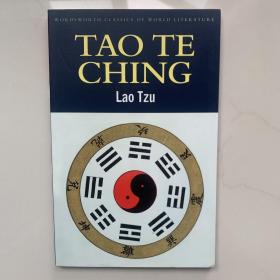
英文原版 Tao Te Ching
全新上海
¥ 28.00
-
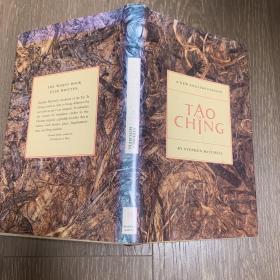
英文原版Tao Te Ching
九品上海
¥ 536.60
-
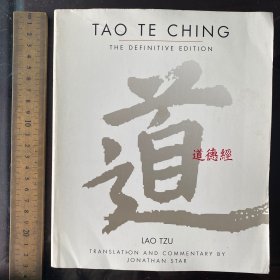
Tao te Ching daodejing laozi 道德经 英文原版
九品广州
¥ 599.00
-

Tao Te Ching (Signet Classics) daodejing laozi 英文原版
九品广州
¥ 139.00
-

英文原版Lao tzu tao te ching老子道德经
八五品泉州
¥ 55.00
-
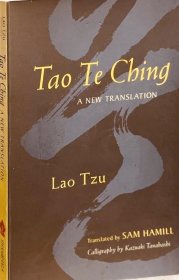
Tao Te Ching:A New Translation道德经 英文原版
九品广州
¥ 299.00
-
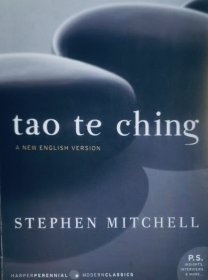
Tao Te Ching taodejing laozi Lao zi道德经 英文原版
九品广州
¥ 199.00
-
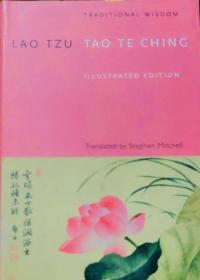
LAO TZU Tao Te Ching 老子道德经 插图版 英文原版
九品广州
¥ 199.00
-

英文原版 老子道德经 Tao Te Ching Lao Tzu Signet Classics
全新广州
¥ 44.00
-

道德经 英文原版 Penguin Great Ideas : Tao Te Ching Lao Tzu
九五品吉安
¥ 62.80
— 没有更多了 —












以下为对购买帮助不大的评价